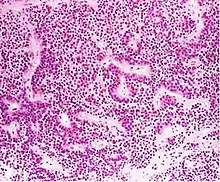.jpg.webp) NK cell |
Null cells are large, circulating white blood cells that resemble T or B lymphocytes but which lack their characteristic surface receptors. The most common type of null cell is the natural killer cell (NK cell). A small minority of null cells are hematopoietic stem cells in free circulation around the body.[1] Aside from these normal human cells, mutant null cells may be associated with several forms of disease.
Role in cancer

Pathological (abnormal and disease-associated) null cells have been found in some cancers, such as null cell adenomas of the pituitary gland. These tumors are usually slow-growing, but have poorly-understood patterns of hormone secretion and may cause necrosis of brain tissue in and around the tumor.[2] Null cells have also been identified in the nontumorous adenohypophysis, suggesting that null cell adenomas are derived from preexisting benign null cells.[3]
Viruses
Cytomegalovirus is known to sometimes cause T-lymphocytes to stop expressing CD28 and other vital surface molecules, rendering them as a form of null cell. However, since they lack other features of NK cells, these altered lymphocytes do not contribute to the immune system and are thus associated with immunodeficiency.[4]
See also
References
- ↑ Paulsen, D.F. (2022). "Chapter 12: Peripheral Blood". Histology and Cell Biology: Examination & Board Review (6th ed.). McGraw Hill.
- ↑ Ogawa, Yoshikazu; Watanabe, Mika; Tominaga, Teiji (June 2010). "Somatostatin-Producing Atypical Null Cell Adenoma Manifesting as Severe Hypopituitarism and Rapid Deterioration—Case Report". Endocrine Pathology. 21 (2): 130–134. doi:10.1007/s12022-010-9110-2. ISSN 1046-3976.
- ↑ Kovacs, Kalman; Horvath, Eva; Ryan, Nancy; Ezrin, Calvin (1980-06-01). "Null cell adenoma of the human pituitary". Virchows Archiv A. 387 (2): 165–174. doi:10.1007/BF00430697. ISSN 1432-2307. PMID 7456308. S2CID 9959115.
- ↑ Shabir, S.; Smith, H.; Kaul, B.; Pachnio, A.; Jham, S.; Kuravi, S.; Ball, S.; Chand, S.; Moss, P.; Harper, L.; Borrows, R. (April 2016). "Cytomegalovirus-Associated CD4+CD28null Cells in NKG2D-Dependent Glomerular Endothelial Injury and Kidney Allograft Dysfunction". American Journal of Transplantation. 16 (4): 1113–1128. doi:10.1111/ajt.13614.
External links
- Null+cells at the U.S. National Library of Medicine Medical Subject Headings (MeSH)